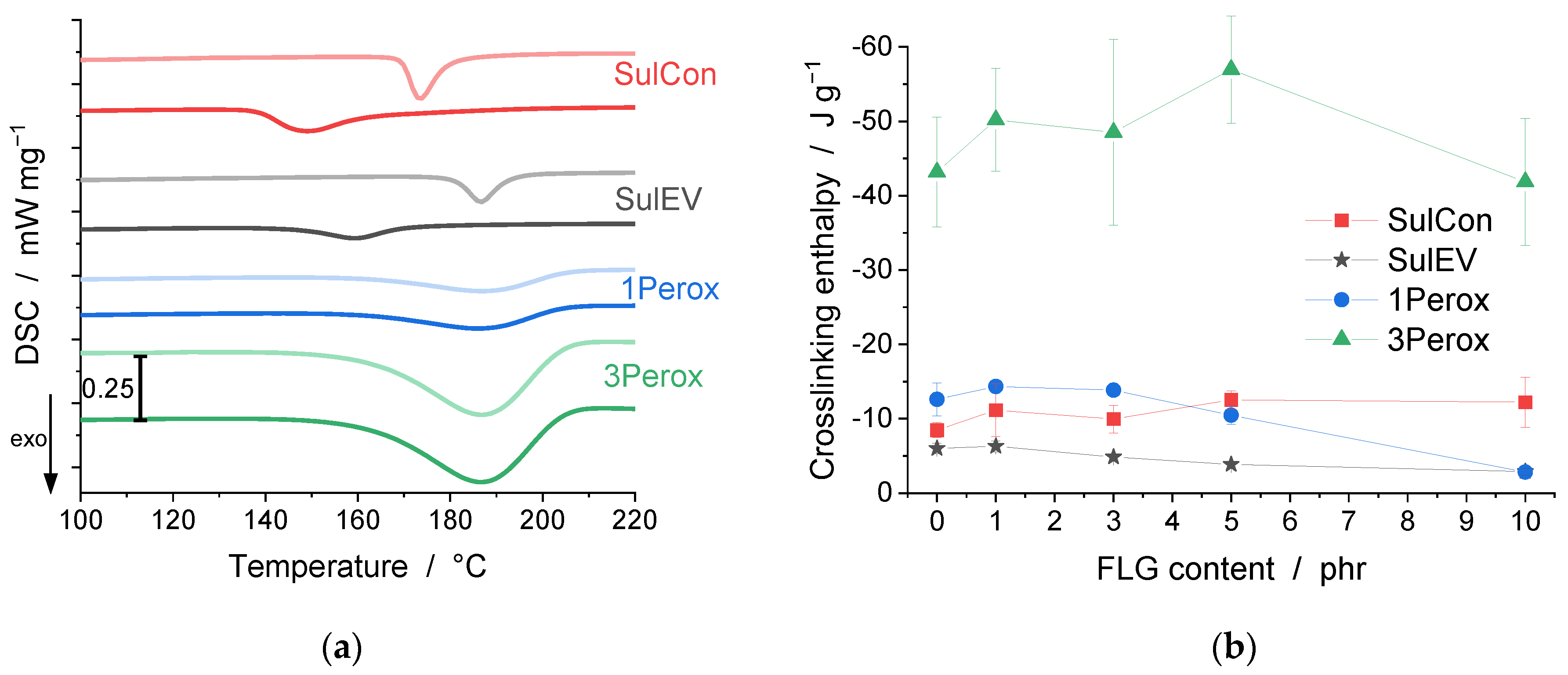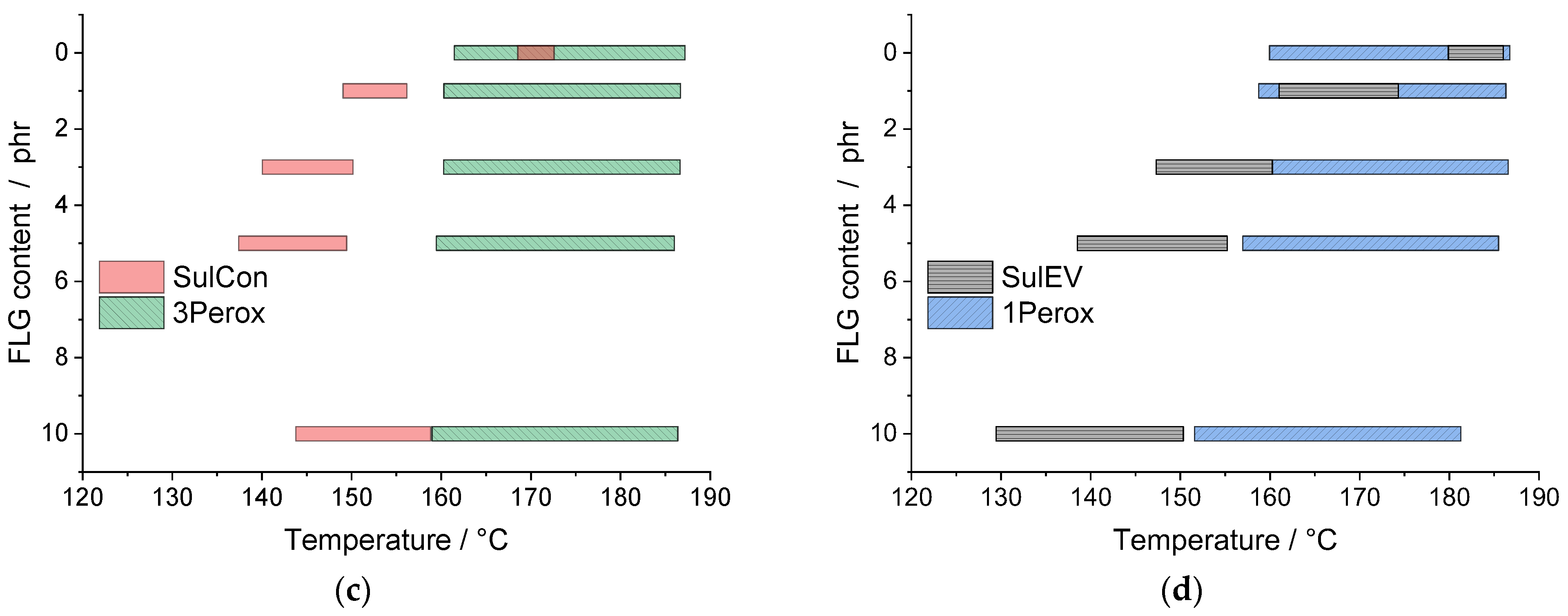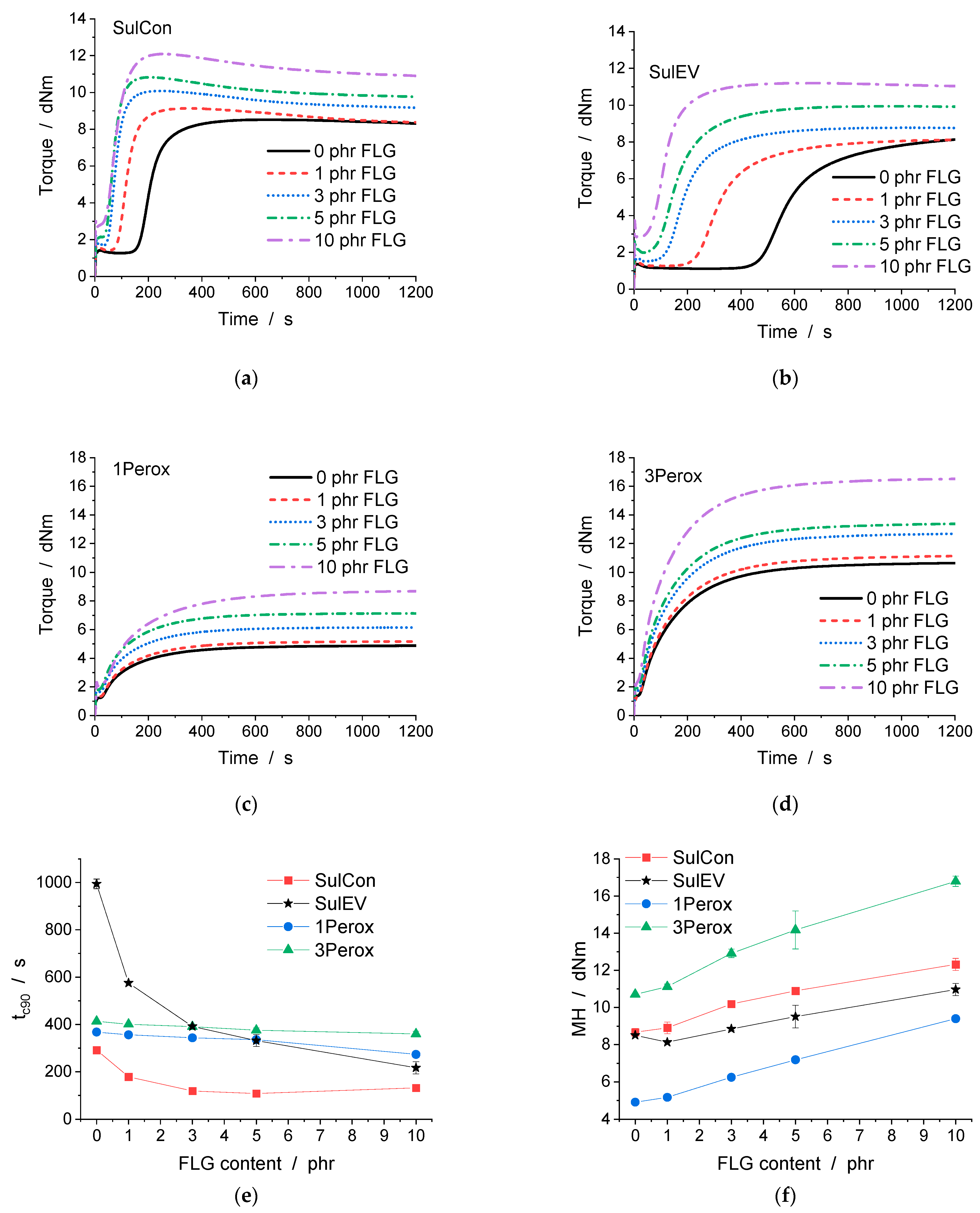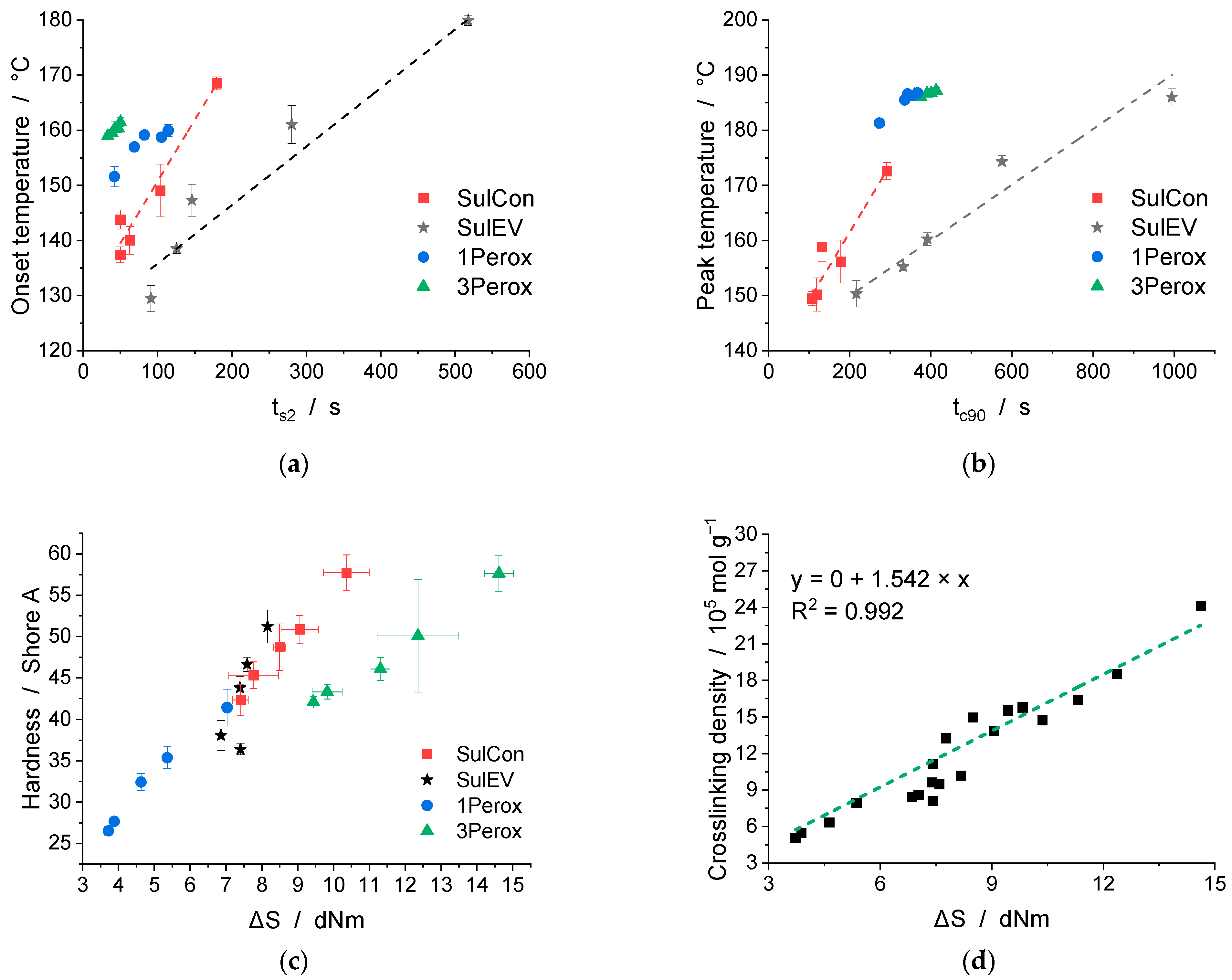Networking Skills: The Effect of Graphene on the Crosslinking of Natural Rubber Nanocomposites with Sulfur and Peroxide Systems
Abstract
1. Introduction
2. Materials and Methods
2.1. Materials and Preparation
- Masterbatch premixing: 30 g of few-layer graphene (FLG, available as EXG R 98 300 from Graphit Kropfmühl GmbH, Untergriesbach, Germany) with a specific surface area (Brunauer–Emmett–Teller (BET)) of 326 m2 g−1 was introduced into distilled water at a concentration of 10 g L−1, followed by 5 min of mechanical stirring (stirring unit Ministar 20 digital with anchor stirrer R 1331, IKA®-Werke GmbH & CO.KG, Staufen, Germany) and an ultrasonication step of 1 h (UPS 400 S ultrasonicator with an H3 sonotrode, Hielscher Ultrasonics GmbH, Teltow, Germany). Then 100 g of natural rubber latex (high ammonia, solid content 60%, supplied by Weber & Schaer GmbH & Co. KG, Hamburg, Germany) was added while stirring. The rubber particles surrounding the FLG particles spontaneously started coagulating and thus initiated the formation of the solid masterbatch. Formic acid (5%) was added until the liquid became clear and a uniform solid masterbatch with a rubber-to-FLG ratio of 2:1 was formed (equivalent to 50 phr FLG content). The masterbatch was washed and rinsed until a neutral pH was obtained and put in a ventilating oven for 48 h at 50 °C for drying.
- Compounding: in a microcompounder (MC 15; Xplore Instruments BV, Sittard, The Netherlands) set to 100 °C and 75 rpm, 10 to 12 g of solid natural rubber (TSR-L from Dai Tieng Rubber Corporation, Dau Tieng, Vietnam) was masticated, followed by the addition of a certain amount of masterbatch, depending on the required FLG content in the final nanocomposite (0, 1, 3, 5, and 10 phr FLG). After dispersing and distributing the FLG masterbatch, the curing agents were added and dispersed, depending on the vulcanization system. The exact recipes (Table S1) and mixing protocols (Table S2) are given in the Supplementary Materials. The sulfur-based recipes were selected according to the suppliers’ recommendations [42]. Sulfur with an oil content of 5% was supplied by CS Additive GmbH, Germany, and the activator stearic acid (BAEROCID SP-1 A) from Baerlocher GmbH, Unterschleißheim, Germany. The accelerators n-cyclohexyl-2-benzothiazolesulfenamide (CZ, available as Vulkazit CZ/EG-C) and the activator zinc oxide (Zinkoxyd aktiv) were purchased from Lanxess Deutschland GmbH, Germany. Tetramethylthiuram disulfide (TMTD, available as Dimacit TMTD-PDR-D) was purchased from Taminco N.V., Ghent, Belgium. Dicumyl peroxide (Perkadox BC-FF) was supplied from Akzo Nobel Functional Chemicals B.V, Amsterdam, Netherlands. Carbon black (CB, Corax® N 330) was bought from Orion Engineered Carbons GmbH, Senningerberg, Grand Duchy of Luxembourg.
- Vulcanization: disc-shaped specimens with diameters of 36.6 mm and thicknesses of 2 mm were vulcanized in a hot press at 150 °C (SulCon and SulEV) or at 170 °C (1Perox and 3Perox) and 300 bar pressure. For high material efficiency, respective molds were used. The vulcanization times in the hot press were set according to the optimum curing times tc90 obtained from vulcameter measurements (presented in Section 3.2) and differed for each curing system and FLG content.
2.2. Characterization Methods
3. Results
3.1. Differential Scanning Calorimetry
3.2. Vulcametry/Moving Die Rheometer
3.3. Sorption and Swelling Measurements
3.4. Hardness
4. Discussion
- Activator A and accelerator X form an A–X complex;
- The A–X complex reacts with sulfur S8 and forms an A–X–Sx complex;
- With the polymer chain R–H, a rubber-bound intermediate R–Sy–X is formed;
- The accelerator X is replaced by another R–H, forming the initial polysulfide crosslinks R–Sx–R;
- Crosslinking shortening, additional crosslinking, crosslinking deconstruction, S–S bond interchange, and main-chain modifications;
- Final vulcanizate network.
5. Conclusions
Supplementary Materials
Author Contributions
Funding
Data Availability Statement
Acknowledgments
Conflicts of Interest
References
- Akiba, M.; Hashim, A.S. Vulcanization and crosslinking in elastomers. Prog. Polym. Sci. 1997, 22, 475–521. [Google Scholar] [CrossRef]
- Kruželák, J.; Sýkora, R.; Hudec, I. Sulphur and peroxide vulcanisation of rubber compounds–overview. Chem. Pap. 2015, 70, 1533–1555. [Google Scholar] [CrossRef]
- Kruželák, J.; Hložeková, K.; Kvasničáková, A.; Tomanová, K.; Hudec, I. Application of Sulfur and Peroxide Curing Systems for Cross-Linking of Rubber Composites Filled with Calcium Lignosulfonate. Polymers 2022, 14, 1921. [Google Scholar] [CrossRef]
- Röthemeyer, F.; Sommer, F. Kautschuktechnologie: Werkstoff-Verarbeitung-Produkte; Carl Hanser Verlag GmbH & Company KG: Munich, Germany, 2013. [Google Scholar]
- González, L.; Rodriguez, A.; Valentin, J.L.; Marcos-Fernández, A.; Posadas, P. Conventional and Efficient Crosslinking of Natural Rubber. KGK Rubberpoint 2005, 58, 638–646. [Google Scholar]
- Nardelli, F.; Calucci, L.; Carignani, E.; Borsacchi, S.; Cettolin, M.; Arimondi, M.; Giannini, L.; Geppi, M.; Martini, F. Influence of Sulfur-Curing Conditions on the Dynamics and Crosslinking of Rubber Networks: A Time-Domain NMR Study. Polymers 2022, 14, 767. [Google Scholar] [CrossRef] [PubMed]
- Dluzneski, P.R. Peroxide Vulcanization of Elastomers. Rubber Chem. Technol. 2001, 74, 451–492. [Google Scholar] [CrossRef]
- Rajan, R.; Varghese, S.; George, K.E. Kinetics of Peroxide Vulcanization of Natural Rubber. Prog. Rubber Plast. Recycl. Technol. 2012, 28, 201–220. [Google Scholar] [CrossRef]
- Araby, S.; Philips, B.; Meng, Q.; Ma, J.; Laoui, T.; Wang, C.H. Recent advances in carbon-based nanomaterials for flame retardant polymers and composites. Compos. Part B 2021, 212, 108675. [Google Scholar] [CrossRef]
- Bokobza, L. Natural Rubber Nanocomposites: A Review. Nanomaterials 2019, 9, 12. [Google Scholar] [CrossRef]
- Hernández, M.; Bernal, M.d.M.; Verdejo, R.; Ezquerra, T.A.; López-Manchado, M.A. Overall performance of natural rubber/graphene nanocomposites. Compos. Sci. Technol. 2012, 73, 40–46. [Google Scholar] [CrossRef]
- Papageorgiou, D.G.; Kinloch, I.A.; Young, R.J. Graphene/elastomer nanocomposites. Carbon 2015, 95, 460–484. [Google Scholar] [CrossRef]
- Prioglio, G.; Agnelli, S.; Conzatti, L.; Balasooriya, W.; Schrittesser, B.; Galimberti, M. Graphene Layers Functionalized with A Janus Pyrrole-Based Compound in Natural Rubber Nanocomposites with Improved Ultimate and Fracture Properties. Polymers 2020, 12, 944. [Google Scholar] [CrossRef] [PubMed]
- Strommer, B.; Battig, A.; Frasca, D.; Schulze, D.; Huth, C.; Böhning, M.; Schartel, B. Multifunctional Property Improvements by Combining Graphene and Conventional Fillers in Chlorosulfonated Polyethylene Rubber Composites. ACS Appl. Polym. Mater. 2022, 4, 1021–1034. [Google Scholar] [CrossRef]
- Battig, A.; Fadul, N.; Frasca, D.; Schulze, D.; Schartel, B. Multifunctional graphene nanofiller in flame retarded polybutadiene/chloroprene/carbon black composites. e-Polymers 2021, 21, 244–262. [Google Scholar] [CrossRef]
- Duy, L.N.P.; Bui, C.; Nguyen, L.T.; Nguyen, T.H.; Tung, N.T.; La, D.D. Dioctyl Phthalate-Modified Graphene Nanoplatelets: An Effective Additive for Enhanced Mechanical Properties of Natural Rubber. Polymers 2022, 14, 2541. [Google Scholar] [CrossRef] [PubMed]
- Frasca, D.; Schulze, D.; Boehning, M.; Krafft, B.; Schartel, B. Multilayer graphene chlorine isobutyl isoprene rubber nanocomposites: Influence of the multilayer graphene concentration on physical and flame-retardant properties. Rubber Chem. Technol. 2016, 89, 316–334. [Google Scholar] [CrossRef]
- Frasca, D.; Schulze, D.; Wachtendorf, V.; Krafft, B.; Rybak, T.; Schartel, B. Multilayer Graphene/Carbon Black/Chlorine Isobutyl Isoprene Rubber Nanocomposites. Polymers 2016, 8, 95. [Google Scholar] [CrossRef]
- Jia, F.; Liu, C.; Yang, B.; Lee, A.; Wu, L.; Ning, H. Preparation of Novel Graphene/Silicone Rubber Nanocomposite Dielectric Foams. Polymers 2022, 14, 3273. [Google Scholar] [CrossRef] [PubMed]
- Zirnstein, B.; Tabaka, W.; Frasca, D.; Schulze, D.; Schartel, B. Graphene/hydrogenated acrylonitrile-butadiene rubber nanocomposites: Dispersion, curing, mechanical reinforcement, multifunctional filler. Polym. Test. 2018, 66, 268–279. [Google Scholar] [CrossRef]
- Frasca, D.; Schulze, D.; Wachtendorf, V.; Huth, C.; Schartel, B. Multifunctional multilayer graphene/elastomer nanocomposites. Eur. Polym. J. 2015, 71, 99–113. [Google Scholar] [CrossRef]
- Frasca, D.; Schulze, D.; Wachtendorf, V.; Morys, M.; Schartel, B. Multilayer graphene/chlorine-isobutene-isoprene rubber nanocomposites: The effect of dispersion. Polym. Adv. Technol. 2016, 27, 872–881. [Google Scholar] [CrossRef]
- Potts, J.R.; Shankar, O.; Murali, S.; Du, L.; Ruoff, R.S. Latex and two-roll mill processing of thermally-exfoliated graphite oxide/natural rubber nanocomposites. Compos. Sci. Technol. 2013, 74, 166–172. [Google Scholar] [CrossRef]
- Zhan, Y.H.; Wu, J.K.; Xia, H.S.; Yan, N.; Fei, G.X.; Yuan, G.P. Dispersion and Exfoliation of Graphene in Rubber by an Ultrasonically-Assisted Latex Mixing and In situ Reduction Process. Macromol. Mater. Eng. 2011, 296, 590–602. [Google Scholar] [CrossRef]
- Mensah, B.; Gupta, K.C.; Kim, H.; Wang, W.; Jeong, K.U.; Nah, C. Graphene-reinforced elastomeric nanocomposites: A review. Polym. Test. 2018, 68, 160–184. [Google Scholar] [CrossRef]
- Wu, J.; Xing, W.; Huang, G.; Li, H.; Tang, M.; Wu, S.; Liu, Y. Vulcanization kinetics of graphene/natural rubber nanocomposites. Polymer 2013, 54, 3314–3323. [Google Scholar] [CrossRef]
- Kim, D.Y.; Park, J.W.; Lee, D.Y.; Seo, K.H. Correlation between the Crosslink Characteristics and Mechanical Properties of Natural Rubber Compound via Accelerators and Reinforcement. Polymers 2020, 12, 2020. [Google Scholar] [CrossRef] [PubMed]
- Hosseini, S.M.; Razzaghi-Kashani, M. Catalytic and networking effects of carbon black on the kinetics and conversion of sulfur vulcanization in styrene butadiene rubber. Soft Matter 2018, 14, 9194–9208. [Google Scholar] [CrossRef] [PubMed]
- Zhang, H.; Xing, W.; Li, H.; Xie, Z.; Huang, G.; Wu, J. Fundamental researches on graphene/rubber nanocomposites. Adv. Ind. Eng. Polym. Res. 2019, 2, 32–41. [Google Scholar] [CrossRef]
- Sui, G.; Zhong, W.; Yang, X.; Zhao, S. Processing and Material Characteristics of a Carbon-Nanotube-Reinforced Natural Rubber. Macromol. Mater. Eng. 2007, 292, 1020–1026. [Google Scholar] [CrossRef]
- Lakshminarayanan, S.; Gelves, G.A.; Sundararaj, U. Vulcanization behavior and mechanical properties of organoclay fluoroelastomer nanocomposites. J. Appl. Polym. Sci. 2012, 124, 5056–5063. [Google Scholar] [CrossRef]
- Sepehri, A.; Razzaghi-Kashani, M.; Ghoreishy, M.H.R. Vulcanization kinetics of butyl rubber–clay nanocomposites and its dependence on clay microstructure. J. Appl. Polym. Sci. 2012, 125, E204–E213. [Google Scholar] [CrossRef]
- Somaweera, D.; Abeygunawardane, G.A.; Weragoda, S.; Ranatunga, S. Effect of vein graphite powder on mechanical, curing, and thermal properties of solid tire vulcanizate. Mater. Today Proc. 2022, 59, 316–323. [Google Scholar] [CrossRef]
- Charoeythornkhajhornchai, P.; Khamloet, W.; Nungjumnong, P. Effect of carbon allotropes on foam formation, cure characteristics, mechanical and thermal properties of NRF/carbon composites. J. Cell. Plast. 2022, 58, 41–57. [Google Scholar] [CrossRef]
- Malas, A.; Das, C. Effect of graphene oxide on the physical, mechanical and thermo-mechanical properties of neoprene and chlorosulfonated polyethylene vulcanizates. Compos. Part B 2015, 79, 639–648. [Google Scholar] [CrossRef]
- Mensah, B.; Gupta, K.; Kang, G.; Lee, H.; Nah, C. A comparative study on vulcanization behavior of acrylonitrile-butadiene rubber reinforced with graphene oxide and reduced graphene oxide as fillers. Polym. Test. 2019, 76, 127–137. [Google Scholar] [CrossRef]
- Mensah, B.; Kang, S.I.; Wang, W.; Nah, C. Effect of graphene on polar and nonpolar rubber matrices. Mech. Adv. Mater. Mod. Process. 2018, 4, 1. [Google Scholar] [CrossRef]
- Varghese, T.V.; Ajith Kumar, H.; Anitha, S.; Ratheesh, S.; Rajeev, R.S.; Lakshmana Rao, V. Reinforcement of acrylonitrile butadiene rubber using pristine few layer graphene and its hybrid fillers. Carbon 2013, 61, 476–486. [Google Scholar] [CrossRef]
- Tang, M.; Xing, W.; Wu, J.; Huang, G.; Li, H.; Wu, S. Vulcanization kinetics of graphene/styrene butadiene rubber nanocomposites. Chin. J. Polym. Sci. 2014, 32, 658–666. [Google Scholar] [CrossRef]
- Innes, J.R.; Young, R.J.; Papageorgiou, D.G. Graphene Nanoplatelets as a Replacement for Carbon Black in Rubber Compounds. Polymers 2022, 14, 1204. [Google Scholar] [CrossRef]
- Xing, W.; Li, H.; Huang, G.; Cai, L.-H.; Wu, J. Graphene oxide induced crosslinking and reinforcement of elastomers. Compos. Sci. Technol. 2017, 144, 223–229. [Google Scholar] [CrossRef]
- Kempermann, T. Handbuch für Die Gummi-Industrie; Bayer AG: Leverkusen, Germany, 1991; Volume 2. [Google Scholar]
- Flory, P.J.; Rehner, J.J. Statistical Mechanics of Cross-Linked Polymer Networks II. Swelling. J. Chem. Phys. 1943, 11, 521–526. [Google Scholar] [CrossRef]
- Joseph, R.; George, K.E.; Francls, D.J.; Thomas, K.T. Polymer-Solvent Interaction Parameter for NR/SBR and NR/BR Blends. Int. J. Polym. Mater. Polym. Biomater. 1987, 12, 29–34. [Google Scholar] [CrossRef]
- ISO 48-4:2021-2; Rubber, Vulcanized or Thermoplastic–Determination of Hardness—Part 4: Indentation Hardness by Durometer Method (Shore Hardness). International Organization for Standardization: Geneva, Switzerland, 2021.
- Bateman, L.; Association, N.R.P.R. The Chemistry and Physics of Rubber-Like Substances: Studies of the Natural Rubber Producers’ Research Association; Bateman, L., Ed.; Maclaren: London, UK, 1963. [Google Scholar]
- Morrison, N.J.; Porter, M. Temperature Effects on the Stability of Intermediates and Crosslinks in Sulfur Vulcanization. Rubber Chem. Technol. 1984, 57, 63–85. [Google Scholar] [CrossRef]








Publisher’s Note: MDPI stays neutral with regard to jurisdictional claims in published maps and institutional affiliations. |
© 2022 by the authors. Licensee MDPI, Basel, Switzerland. This article is an open access article distributed under the terms and conditions of the Creative Commons Attribution (CC BY) license (https://creativecommons.org/licenses/by/4.0/).
Share and Cite
Strommer, B.; Schulze, D.; Schartel, B.; Böhning, M. Networking Skills: The Effect of Graphene on the Crosslinking of Natural Rubber Nanocomposites with Sulfur and Peroxide Systems. Polymers 2022, 14, 4363. https://doi.org/10.3390/polym14204363
Strommer B, Schulze D, Schartel B, Böhning M. Networking Skills: The Effect of Graphene on the Crosslinking of Natural Rubber Nanocomposites with Sulfur and Peroxide Systems. Polymers. 2022; 14(20):4363. https://doi.org/10.3390/polym14204363
Chicago/Turabian StyleStrommer, Bettina, Dietmar Schulze, Bernhard Schartel, and Martin Böhning. 2022. "Networking Skills: The Effect of Graphene on the Crosslinking of Natural Rubber Nanocomposites with Sulfur and Peroxide Systems" Polymers 14, no. 20: 4363. https://doi.org/10.3390/polym14204363
APA StyleStrommer, B., Schulze, D., Schartel, B., & Böhning, M. (2022). Networking Skills: The Effect of Graphene on the Crosslinking of Natural Rubber Nanocomposites with Sulfur and Peroxide Systems. Polymers, 14(20), 4363. https://doi.org/10.3390/polym14204363







